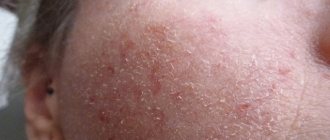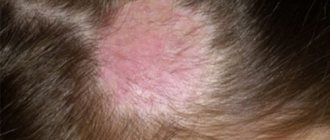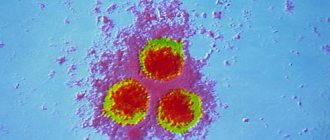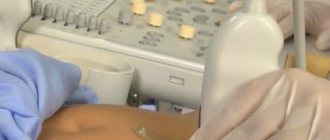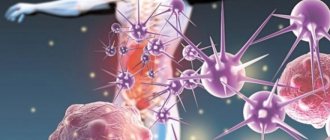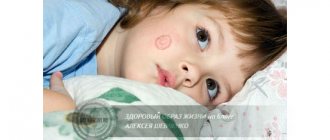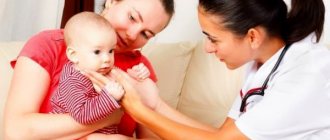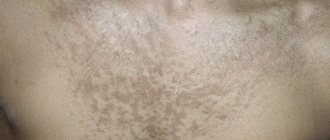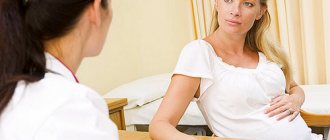What is lichen planus
Lichen planus is a chronic skin disease that can also spread to the mucous membranes and nail beds.
The disease is characterized by severe itching of the affected skin surface. This type of lichen has the following occurrence statistics:
- 1.5% among skin diseases;
- 35% among diseases of the oral mucosa.
It often occurs in response to internal organic disorders in the body.
The disease is more common in adults than in children.
Varieties and atypical forms
There are several types of the disease, which differ in their symptoms:
- typical shape
- ring-shaped,
- erythematous,
- warty (sometimes called verrucous),
- pemphigoid,
- atrophic,
- erosive-ulcerative.
There are also very rare types - obtuse, serpiginous, erythematous.
Lichen planus is changing, and now the pathology has characteristics that did not exist several decades ago. This is due to environmental changes, frequent use of antibiotics and other factors.
The disease today has the following features:
- relapses occur faster;
- Atypical variants of the disease occur more often;
- cases of malignant transformation of affected cells have become more frequent (up to 10-12%).
Reasons for appearance
The disease was first identified in 1860, but since then doctors have not been able to determine exactly what the prerequisites for its appearance are.
Today, doctors do not have a common opinion about the origin of lichen. This is partly why there are no therapeutic agents that eliminate the cause of this disease and cure it completely. Scientists can identify only a certain group of factors that contribute to the occurrence of the disease:
- Genetic predisposition (genetically predetermined characteristics of immunity).
- Internal disorders (immune problems, neurological problems).
- External influences (the influence of viruses, allergens, side effects of using certain drugs).
On the surface of the body there are characteristic places that are most susceptible to lichen planus - the joint area of the wrist, forearm, lower leg, sacrum, skin of the penis. Speaking of mucous membranes, plaques appear in the mouth and genitals.
Is lichen ruber contagious?
There is no definite answer to this question, since all theories about the occurrence of this dermatosis are currently unproven. However, there are known cases of lichen planus occurring in members of the same family, including both spouses. In addition, an episode of infection of a doctor who took tissue from a patient’s lesion (biopsy) for further research is described. A month after the manipulation, his first single lesion appeared, and three weeks later, new numerous rashes, identical to those that his patient had.
Therefore, we should not forget that infection is probably still possible, but most likely through close contact. And if you live with a sick person, then make it a rule: do not share scissors, a razor, a toothbrush cup, underwear, a towel, clothes or shoes with him.
Why is it dangerous?
A complication of lichen can be stomatitis.
If you identify the red form of lichen in a child in time and carry out treatment, the outcome is favorable. Otherwise, the usual form of the disease turns into erosive-ulcerative and a significant part of the oral mucosa is injured. In this case, secondary bacterial infection is often observed, aggravating the situation. The following complications of advanced lichen planus in a child are possible:
- development of an advanced form of pathology, which increases symptoms and treatment time;
- accession of stomatitis.
Localization
Lichen planus differs significantly from other forms of this disease. As a rule, the inflammatory process manifests itself in the following places:
- joints and forearms in the flexion area;
- neck area;
- shin;
- external genitalia in men.
As for the mucous membrane, the infection manifests itself in the following places:
- mucous membrane of the genital organs;
- oral mucosa.
Pathology most often manifests itself in the mouth. At the initial stage of development, lichen planus symptoms resemble ordinary stomatitis. However, medications to treat stomatitis do not provide any relief.
Signs and symptoms
Most often, lichen planus is localized in the joints of the arms or legs, forearms, legs, and on the sacrum. Among the mucous membranes, the human genitals and mouth are more susceptible to pathology. It should be noted that the disease has several strains, each of which is different from the others in its symptoms. However, the main signs of the development of the disease are the following:
- For the typical form, these are rashes on the upper layer of the epidermis in the form of small formations, colored grayish-white. During development, such plaques begin to shine (with the exception of the mucous membranes);
- Ring-shaped forms, most often affecting the mucous membranes of the genital organs, and having the characteristic outlines of rings;
- Pemphigoid formations are accompanied by blistering rashes. Sometimes the color does not differ from the color of healthy skin;
- Verrucous verrucous has a unique scaly structure, in appearance it resembles a flat plantar wart with a slightly perforated upper layer;
- Erythematous form - the formations are painted in a bright scarlet or crimson color, the structure is soft and plastic.
- Atrophic lichen ruber - pearlescent light spots;
- The erosive form is a characteristic rash on the skin of the arms or legs in the form of small, pronounced ulcerative formations with a vague outline and epithelial lesions.
As you can see, there are many varieties of lichen ruber in humans, so treatment can only be prescribed by a specialist after conducting a visual examination and identifying a certain typical or atypical strain of the pathology.
Unfortunately, modern ecology and food have dramatically changed the course of many skin diseases, including lichen ruber. The often unjustified use of a large number of antibiotics in human treatment also plays a large role in this evolution. The peculiarities of the course of the disease today are incomparable with the descriptions of Gebr or Bekhterev. Too frequent relapses and the transition from classical forms to ulcerative-erosive ones force doctors to look for new odds and methods of treating the disease in order to prevent the formation from transforming into malignant cells.
Symptoms of lichen planus
Lichen planus in humans, despite the peculiarities of its course in various forms, has common features that help distinguish it from other skin diseases.
| Group of symptoms | Specific manifestations |
| Localization | Often: elbow bends, surfaces of the forearms, in the armpits, on the abdomen, on the thighs, near or directly on the genitals, on the legs and lower back. Uncommon: all mucous membranes. Very rare: scalp. |
| The patient's feelings | Often: accompanied by itching, which is difficult to control. Not often: in addition to severe itching, painful sensations are present, especially with the development of erosions and ulcers. Rarely: there are no unpleasant sensations at all. |
| Additional symptoms | In most cases, even if typical lichen rashes do not affect the oral mucosa, there are subtle white rashes on it. They can be identified by their location - close proximity in a line. |
| Residual effects | Often: after all the plaques have healed, spots of increased pigmentation remain in their place. Rarely: severe damage to the skin can cause areas of hyperkeratosis and thickening to appear after healing. |
| Inflammatory component | Lichen planus occurs without an inflammatory process. Cases of inflammation are possible if infection occurs through open wounds. |
Therapy
How to treat lichen planus in a person should be decided by the doctor personally based on the symptoms.
To relieve itching the following is prescribed:
- medications that eliminate allergy symptoms (Erius, Clarisens);
- sedatives;
- medications to help you sleep;
- hormonal ointments (Prednisolone, Hydrocortisone).
When a bacterial infection occurs, antibiotic therapy is prescribed. When large areas are involved in the pathological process, immunosuppressants are prescribed. To restore a healthy appearance to the skin, it is recommended to take tocopherol and retinol. In case of relapses, Actovegin is prescribed, which eliminates hypoxia.
In addition to medications, the patient is prescribed physical therapy: electrosleep, acupuncture.
Therapy of mucous membranes
Treatment for lichen planus in the mouth consists of rinsing with a soda solution and following a diet. The following rules must be adhered to:
- reduce the amount of salt and sugar;
- exclude rich and allergenic foods, hot and irritating dishes, ice cream from the menu;
- do not drink coffee, alcohol, hot tea, sweet soda;
- Jelly and puree soups are allowed.
After eating, rinse your mouth with a solution of herbs that have an antiseptic effect, this will reduce the risk of infection from erosion. You can use chamomile or marigold. In addition, the following recommendations must be followed:
- treat carious teeth;
- exclude contact with the allergen;
- prevent exacerbation of chronic pathologies;
- maintain a sleep-wake schedule;
- learn how to properly cope with stressful situations.
Conclusion
Sometimes lichen planus develops into cancer, so if signs of the disease appear, you should immediately consult a doctor and undergo therapy.
Stages and degrees of lichen planus
Depending on the form of the disease, the course of the disease will change.
Typical shape
It has a classic scenario for the course of the disease:
- It starts with the appearance of small spots from 2 to 3 mm on the skin. They are pink-violet or crimson-red in color. The surface is always shiny. They have slight depressions in the middle and rise above the surface of the skin.
- After some time, the spots increase and merge into plaques. The surface begins to peel off. Severe pain and itching occurs. In 25% of patients, there are no rashes on the skin, they are observed only on the mucous membrane - the mouth, the vestibule of the vagina, the glans penis. When nails are affected, cloudy spots appear and the nail bed takes on a red tint.
- Gradually, the plaques fade, heal, and the skin surface is restored. In place of the plaques, barely noticeable spots remain, which differ in color from the surrounding skin. They pass with time.
Ring shape
More often found near the genital organs, mainly in men:
- The formed plaques continue to increase and merge into a single large spot.
- After some time, the middle plaques begin to heal and a patch of healthy skin appears in the center of the spot, which has a brighter color than the color of the normal healthy skin of this person. This is how half rings and arcs of the affected skin can form.
Due to the proximity of the genitals, this form is often confused with syphilis. In this case, differential diagnosis is very important.
Bullous form
A rare form of the disease, occurring in approximately 3% of patients. It appears in the form of nodules and bubbles of different sizes rising above the surface.
They are often localized on the lateral surface of the tongue and in the area of the palatine arches. The bubbles persist for several hours, after which they open, forming erosive areas. Erosions are sensitive and easily injured; if damaged, they can bleed.
Hypertrophic form
This form of lichen is most often located on the front surface of the lower leg. Violet or brown-brown rashes appear. Already formed plaques are covered on top with wart inclusions.
There are small rashes around that occur during a typical course. This form is the most difficult to treat.
Pemphigoid form
Otherwise called bubbly:
- Instead of the classic rash and plaques, blisters filled with liquid appear. In some cases, an admixture of blood is found in the blisters.
- Often this form is combined with a typical one or occurs independently.
- The blisters heal over time, decreasing in size and taking on the appearance of a classic rash.
Moliniform form
This variety can be called nodular.
Affects the forehead, neck, buttocks, back of the neck and ears, elbow bends, back of the hands, abdomen:
- Round nodules are formed, slightly raised above the surface of the skin. They are the size of a cherry bone. They appear one after another and form dense chains or stripes.
- Over time, the nodes shrink, taking on the appearance of a normal rash. The disease ends according to the classical type.
Hyperkeratotic
This form is observed in rare cases. Its peculiarity is the different outlines of the grayish plaques. Hyperkeratotic nodules rise significantly above the surface of the mucous membrane and have pronounced boundaries.
Lesions are mainly observed on the tongue and inner cheeks.
Atrophic form
This is a rare type of development of lichen ruber as it affects the scalp.
We can say that it leaves behind the most consequences:
- The onset of the disease is similar to the typical form. A rash appears, then plaques form.
- But after the plaques heal, what remains is not clean skin, but areas of atrophy and tissue compaction. The affected areas of the head lose hair, and patchy baldness occurs.
Pointed shape
The second name for this form is perifollicular.
Often affects the scalp:
- The onset of the disease is typical; first, rashes characteristic of the typical course appear.
- Then cone-shaped nodules appear, with a spike at the top. This cone is formed from the affected hair follicle.
- After the cones heal, minor depressions appear in their place, and miniature nodules may remain in some of them.
Exudative-hyperemic form
This form of the disease is quite rare. Symptoms are expressed in the appearance of nodular formations, redness and swelling of the oral mucosa. Papules often develop into small plaques. The main complaints of patients include pain during conversation and burning sensation when eating food.
Erosive-ulcerative form
It is considered the most dangerous form of the disease, since characteristic open wounds can become a path for infection. Also, this form, if left untreated, can degenerate into a skin neoplasm.
Mainly, mucous membranes are affected by erosions and ulcers:
- A plaque immediately forms on the mucous membrane, which is covered with a thin film. When the covering of the plaque is damaged, bleeding begins.
- The skin surrounding the affected area becomes inflamed, and additional small rashes may appear.
- In place of the plaques, ulcers appear that require treatment. If all rules are followed, ulcers heal successfully without leaving marks.
This form of the disease is the most painless - the affected mucous membrane at all stages does not cause concern to the patient.
Atypical form
A common location for this form is the upper lip and mucous membrane of the gums. It appears in the form of nodular formations rising above the surface, covered with a gray coating. When eating food, the patient often experiences a feeling of discomfort and pain.
Symptoms and area of localization
The main defining signs of the disease are a red dotted rash on the body and accompanying itching. The rashes reach 1 cm in diameter, are characterized by peeling and over time can change color to blue-violet. After treatment, dark pigmented spots remain at the site of the rash.
There are several types of lichen ruber, the symptoms of which differ from the traditional form of the disease.
- Atrophic form
. Initially, the same symptoms appear as in the usual form of lichen, but after the rash disappears, thickening of the skin appears in its place. Typically, this shape is characteristic of the legs, forearms and other flexor parts of the body. If lichen ruber has spread to areas covered with hair, then after the disease the hair on them no longer grows. - Warty form
. The rash takes the form of warts, that is, areas of skin noticeably raised above healthy skin. Mainly localized on the legs. - Pointed shape.
Characteristic of hair. In place of the hair, something similar to a spike forms, which rises above the healthy skin. After the disease, traces in the form of scars may remain. - Ring shape.
Usually localized in the groin area in men. The form is characterized by the fact that the rash on the skin, due to its excessively rapid appearance, twists into a ring-shaped shape. - Bubble shape.
Involves feet and legs. The rash takes the form of vesicles or blisters filled with clear or bloody fluid. A rare form of lichen ruber. - Sclerosing form
. A very rare form of the disease. With this type of lichen, atrophy of the skin may appear.
More on Med-Gribok.Ru:
Pityriasis versicolor (solar)
As mentioned above, the main location of the disease is the flexor areas of the body (legs, forearms, feet, armpits), but the head, groin area, mucous membranes and nails can also be affected. The nail plates are affected in 12-16% of cases of lichen red. Longitudinal grooves and cracks appear on the nails, and gradually the nail plate becomes thin and very fragile.
Mycocin is the latest means of French military medicine for a comprehensive blow to all types of fungus!
The Mikocin complex was developed by special order of the French Foreign Legion in 2020 to protect legionnaires from fungal infections. The military department has calculated that the fungus not only reduces the combat effectiveness of legion units, but also requires a lot of funds for the treatment and rehabilitation of the military.
2in1 — Mikocin complex eliminates itching, odor, and restores the aesthetic appearance of nails
- Mikocin tablets destroy all types of fungus on nails and skin
- Mycocin gel restores the skin and creates a protective barrier on it
DESCRIPTION AND ORDER!
Particular attention should be paid to damage to the mucous membranes, in particular the oral mucosa. Lichen planus in the oral cavity occurs quite often and is characterized by flat white plaques distributed along the inside of the cheeks or tongue. In some cases, the disease can cause severe discomfort in the oral cavity (even to the point of refusing to eat), but most often there is no such side effect.
Diagnosis of lichen planus
The diagnosis is made on the basis of clinical data and histological examination - examination of the affected tissue using a dermatoscope or analysis of material taken during a biopsy.
To select the correct treatment tactics, you must pass:
- detailed blood test - clarifies the diagnosis, excludes inflammatory and allergic processes in the body;
- biochemical blood test - evaluates the functioning of the liver and kidneys;
- General urinalysis - excludes inflammatory diseases of the urinary tract.
To identify or exclude pathologies of internal organs, consultations with other specialists are prescribed:
- ophthalmologist, endocrinologist, therapist, gynecologist - exclude contraindications;
- dentist - evaluates isolated lesions of the oral mucosa.
To do this, a thorough medical history is taken, during which it is important to exclude contact with viruses and taking medications, the reaction to which in terms of symptoms is similar to lichen planus.
Differential diagnosis is carried out with diseases such as secondary syphilis, atopic dermatitis, psoriasis, pityriasis pilaris.
With syphilis, the rash is diverse, represented by dark red papules of the same size, dense at the base, oval in shape, painful when pressed (Jadassohn's symptom). Peeling of the Biette collar type is noted - the appearance of scales along the edges of the papules, when the peeling in the center has already ended. This disease is also characterized by positive serological reactions - the presence of antibodies in the blood serum. With lichen planus, all these signs are not observed; the papules are reddish-violet in color with an umbilical depression in the center, and are distinguished by itching.
In atopic dermatitis, the mucous membranes are not affected. The rash is usually localized on the face, knees and elbows. The skin around the rash thickens.
In psoriasis, the process is represented by red papules, on the surface of which there are white scales.
With pityriasis pilaris (Devergie's disease), yellowish-red papules appear on the skin of the extensor part of the arms and legs, and the back of the fingers (Beignet's symptom - fine peeling when scraped). When the papules merge, a surface resembling a grater is formed, the skin becomes dense and rough. This picture is not typical for lichen planus.
Diagnosis of the disease
The diagnosis of lichen planus is made based on the existing symptoms.
The rule of five Ps is used: polygonal (polygonal), flat, pruritic (itching) and purplish-red papules. The disease should be distinguished from other diseases, which requires a differential diagnosis: With papular syphilis . Often the annular form of lichen is mistaken for syphilitic rashes, since these diseases have a similar localization - the mucous membrane of the oral cavity and genital organs. However, rashes of syphilitic origin are red with a copper tint, and not violet-red. Also, with syphilis, the elements are of the correct shape (oval), less flat and do not have depressions. Syphilitic rashes practically do not itch.
With toxicoderma resulting from long-term treatment with antibacterial drugs, anti-tuberculosis and anti-malarial drugs, bismuth and others. In this case, for the differentiation of diseases, the short duration of the course of toxicoderma, the presence of an anamnesis (medicine treatment) and the study of the elements of the rash using the histological method are of particular importance.
With tuberculosis . Initially occurring rashes with tuberculosis have the shape of a yellow or light brown tubercle, do not have a blue-lilac tint and an indentation in the center. Merged tubercles in tuberculosis can resemble eczema of the seborrheic type. When making a diagnosis in this case, it is necessary to take into account the age of the patient (skin tuberculosis can develop in childhood, and lichen planus - mainly in people after 30 years), the results of the tuberculin test and histology.
With nodular prurigo . This disease is most often differentiated as lichen planus, which occurs as a hypertrophic form. In both pathologies, rashes appear predominantly on the skin of the legs. With pruritus, the rash is always larger, has a clear oval shape, and is usually not numerous. Also, with pruritus, there is no rash on the mucous membranes.
With neurodermatitis . With neurodermatitis, the itching is even more pronounced than with lichen. The rashes vary in color. Also, elements of neurodermatitis have a central infiltrated zone. This is not typical for lichen.
These are just a few skin conditions that can be mistaken for lichen planus. In fact, differential diagnosis has a wider range. The most significant data for differentiating diseases of this group are the data of histological analysis.
Treatment of lichen planus
Most approaches to the treatment of lichen planus consist of eliminating the symptoms of the disease, that is, most of its external manifestations. This means that in each specific case the treatment will be different, since everyone’s disease manifests itself individually.
So, if the main symptom of lichen planus is severe itching, then doctors prescribe the patient antihistamines, sedatives to calm the nervous system, local glucocorticosteroids, and sleeping pills.
If a secondary bacterial infection appears in the area of the rash, it is necessary to start using antibiotics in an average dosage. This must be done, since a protracted fight against microbes leads to a significant weakening of the immune system, which further contributes to the development of skin disease.
Further, the lichen can spread to large areas of the skin or mucous membrane. In this case, its successful treatment is possible only with the use of strong quinolone immunosuppressants, in particular Delagil, Plaquenil and others.
If the disease progresses, glucocorticosteroids, which have an immunosuppressive effect, are also prescribed. They give very quick results regardless of the dosage form.
There are other types of therapeutic effects, in particular, the administration of vitamins, electrosleep, acupuncture, etc. In combination with classical methods of treatment, they give a stable result, which can improve the prognosis of the disease.
Features of therapy
For LP, complex treatment is prescribed, aimed at eliminating unpleasant symptoms and normalizing the functioning of the central nervous system. Depending on the patient's health, the severity of symptoms and the reasons for their occurrence, therapy may vary. It is very important to eliminate the causative factors that provoked the pathology. It is necessary to get rid of internal and external factors.
Principles of treatment for LP
To eliminate lichen on the mucous membrane, local remedies are used in the form of extracts, ointments and oils. Doctors prescribe sedatives and antihistamines only when treating severe forms of the disease. The same applies to antibiotics, which are used in rare cases and only as prescribed by a doctor. It is recommended to supplement drug treatment with physiotherapy and diet.
Medications
Drug treatment is the best way to alleviate the patient’s condition and speed up the healing process of the affected skin.
| Type of drugs and their effect | Name of drugs | Reception scheme | Cost in rubles |
| Herbal sedatives to combat anxiety during itching, help improve disturbed sleep | Valerian tincture | Before meals, 20 to 30 drops with a small amount of water, 3 times a day, course – 7 days. | From 17 |
| Motherwort forte | With meals, 1 tablet, 3 times a day, course – up to 3 weeks. | From 43 | |
| Antihistamines will help relieve inflammation and swelling of affected tissues, reduce an allergic reaction, and reduce itching | Suprastin | During meals, 1 tablet, 3 times a day, course – from 5 days. | From 114 |
| Zodak | 20 drops, 1 time per day, course – from 7 days. | From 205 | |
| Fenistil | 60 drops divided into 3 doses per day, course – from 5 days. | From 390 | |
| Enterosorbents will help cleanse the intestines, improve its functioning, remove toxic substances, and strengthen the immune system. | Zosterin-ultra-60% | 1 sachet in the morning 30 minutes before meals, 1 sachet in the evening 2 hours after meals, course – 10 days. | From 430 |
| Enterosgel | 1 or 2 hours after or before meals, 1 tablespoon should be diluted in water at room temperature. | From 433 | |
| Antiseptics for open wounds to prevent infection | Chlorhexidine (not suitable for oral use) | Treatment of the affected surface using applications with the drug 3 times a day | From 15 |
| Miramistin | From 250 | ||
| Corticosteroid ointments are prescribed in difficult cases when the skin does not recover on its own, when inflammation occurs | Advantan | Apply a thin layer to the affected areas of the skin, 1 time per day, for a course of no more than 10 weeks. | From 525 |
Ointments
Typically, topical medications are not used. But there are situations in which inflammation or its individual manifestations (for example, severe itching) manifest themselves clearly, therefore the use of steroid ointments (prednisolone, hydrocortisone ointment), vegetable oils, and products with phytoextracts is indicated. Their use is effective only to suppress itching; in other cases, internal remedies are used, since the cause of the disease lies inside the body.
Pills
The main treatment for lichen are 4-aminoquinoline derivatives (Chloroquine, Hydroxychloroquine) and hormonal therapy. Antidepressants and sedatives are prescribed as auxiliary agents to combat itching. Doctors often prescribe antihistamines if there is a suspicion that an allergen caused the reaction.
These are the following drugs:
- Claritin,
- Tavegil,
- Telfast et al.
To normalize the body's metabolism and quickly restore the healthy appearance of the skin, certain vitamins are prescribed, in particular, vitamin A (it is responsible for the division of skin cells), carotenoids, vitamin E (increases the effectiveness of hormonal therapy). If the disease is accompanied by frequent relapses, it is possible to use tablets that increase oxygen supply to tissues - Actovegin, Cyto-Mac.
Antibiotics and vitamin complexes
Antibiotics are used exclusively for complicated cases of lichen ruber. They fight pathogenic microflora well. As a rule, tablets from the group of macrolides (Erythromycin, Sumamed) and tetracyclines (Metacycline) are prescribed. Such drugs are not taken in other dosage forms. If there is a progressive infection in the body, Ceftriaxone solution is injected intramuscularly and 3-3.5 g of Amoxicillin is taken. After completing the course of treatment, the patient must take antifungal and immunomodulatory drugs.
To maintain the functioning of the immune system, vitamin complexes (vitamins B, C, D, Tocopherol and Retinol) must be included in the course of therapy. In cases of moderate severity of the disease, they are used in the form of tablets, and in complicated cases - in the form of injections. The complex drug Neovir has proven itself well. Its course use helps reduce vascular permeability and improve protein synthesis in soft tissues.
Antihistamines
Antihistamines are used to relieve itching and reduce the activity of allergens. After their use, epithelization of lesions is observed in some patients. The doctor prescribes antihistamines only if the cause of lichen ruber is direct contact with an allergen. When a pathological process is caused by a malfunction of internal organs, their use is considered inappropriate. The following medications in tablet form are characterized by the greatest effectiveness: Claritin, Erius, Tavegil, Suprastin.
In case of a severe allergic reaction, drugs are prescribed in courses of 7-10 days. Their action is aimed at blocking cellular receptors that are affected by histamine. If after this period it was not possible to overcome lichen ruber, they move on to hormonal therapy. It is highly undesirable to simultaneously use antihistamines and immunomodulatory drugs. This can aggravate the allergenic reaction and cause the Wickham's grid symptom.
Sedatives
Sedative medications are prescribed only in cases of urgent need, when the patient has been tense for a long time. Among the most popular drugs are Medazepam and Phenazepam; the course of treatment lasts approximately 10-14 days.
Corticosteroids
Highly effective corticosteroid drugs, such as Clobetasol, Triamcinolone, used 2-3 times a day for 2 weeks. The drug "Clobetasol" can be purchased for 400 rubles, "Triamcinolone" costs 250-350 rubles.
Diet
There is no special diet for the treatment of lichen planus. However, nutrition plays an important role, because it is impossible to cure lichen planus by abusing foods harmful to the body. In addition, taking some drinks can reduce the effectiveness of drugs, and a number of products can cause allergic reactions and provoke a sharp increase in blood sugar levels.
During the treatment period, you should avoid drinking alcohol and confectionery. Products that it is advisable to limit your consumption include:
- citrus;
- products containing cocoa;
- products containing purine: meat and dishes prepared on its basis (broth, meat sauce, jelly); fatty fish, fish soup, fried and salted fish, canned fish; meat by-products; mushrooms;
- legumes: peas, beans, soybeans, lentils;
- eggs;
- strong brewed tea or coffee;
- products with a high content of preservatives, dyes, flavoring additives: sausages, canned food, carbonated drinks.
The following products will benefit the body:
- dairy;
- green vegetables;
- healing mineral water;
- iron-containing products;
- honey.
A diet for lichen planus is necessary if the disease often recurs and is difficult to treat.
It is better to introduce each new product into the diet gradually. If the condition worsens, the diet should be extended.
Immunotherapy
In the process of complex treatment of lichen planus, supporting the patient's immune defense is of considerable importance. For this purpose, exogenous immunomodulatory drugs of interferon and its inducers are used:
- "Ridostin";
- "Neovir";
- "Reoferon".
For more complex cases of the disease, Cyclosporine may be prescribed. Chronic pathology, accompanied by frequent relapses, requires drugs that fill the tissues with oxygen.
Folk remedies
There are several folk recipes for eliminating lichen planus:
- Herbal collection. Mix chamomile, string and sage (1:1:1) and brew 1 tbsp. l. per glass of boiling water. The product is taken three times a day, it relieves inflammation, calms the nervous system, and strengthens the body.
- To strengthen the fight against skin irritation, prepare cold lotions from a decoction of the string (20 g of herb per 1 cup of boiling water).
- To treat plaques directly, crush 50 g of garlic cloves and infuse in a glass of vodka. Wipe the affected areas of the skin with the product.
- A cabbage leaf has a good effect, the surface of which is smeared with sour cream, after which it is applied to the rash. It alleviates the symptoms of the disease and accelerates skin healing. Traditional methods of treatment cannot be considered as the main ones. They only complement drug therapy prescribed by a doctor, but on their own cannot effectively cope with the disease. Moreover, it is recommended to consult a dermatologist about the self-treatment methods you choose to make sure that they will not harm the body.
Sea buckthorn oil applications
Soak a piece of gauze in sea buckthorn oil and apply it to the affected area of the body for 30-40 minutes. Repeat the procedure daily for 14 days. After just a few days of treatment, the itching will go away, and the size of the lichen will begin to decrease.
Herbal compresses
Mix 1 tbsp in one bowl. l. celandine and willow bark with 3 spoons of mullein flowers. Pour the resulting mixture with 1 liter of boiling water and leave for 40 minutes. Strain the broth and make compresses from it twice a day.
General recommendations
Experts highlight several recommendations for patients prone to relapses of lichen planus in order to combat the disease as successfully as possible:
- eliminate all carious cavities in the mouth using filling;
- visit your dentist regularly;
- find out if you are allergic to something and avoid contact with allergens;
- do not allow the exacerbation of chronic internal diseases, especially those of an infectious nature;
- practice regular rest, eliminate stress at work.
Treatment with folk remedies
Traditional methods of treatment quite successfully complement traditional methods of fighting the disease, significantly reducing pain syndromes. Popular recipes for red lichen:
- Calendula
. You can make an alcohol tincture from this plant yourself or buy it ready-made at a regular pharmacy. Method of preparation: add 20-30 grams of calendula flowers to half a glass of 70% alcohol solution, leave for several hours. Used in the form of compresses. Also, from this plant, more precisely from ground calendula powder, you can make an ointment against red versicolor, for this you need to mix 100 grams of powder with 100 grams of medical petroleum jelly. Treat the surface once a day until signs of the disease disappear. - Beet
. Grated beets are used in the form of compresses applied to sore skin. The beet pulp should be secured with gauze. Apply a compress several times a day. - Sea buckthorn oil.
Can be used both externally and for oral administration. The oil should be taken orally on an empty stomach, half a tablespoon. - Herbal mixture
. You can use juniper fruits, nettle leaves, black elderberry blossom, St. John's wort leaves, and dandelion root. Grind and mix in equal proportions. Pour 2 tablespoons of the resulting mixture with half a liter of boiling water and leave in a dark place for an hour. The tincture should be taken orally 1-2 times a day.
Post Views: 130
What not to do
When treating lichen planus, you should not:
- take medications without the knowledge of a doctor;
- use shower gel that contains chemicals;
- take antibacterial drugs;
- mechanically influence the skin rash (rub or scratch);
- visit a bathhouse, sauna or swimming pool;
- drink alcoholic beverages;
- eat sweets, spicy and fatty foods. If you have lichen, you should not swim
Failure to comply with these rules can lead to negative consequences, for example, self-administration of medications will cause side effects. Therefore, when diagnosing LP, all your actions must be coordinated with your doctor.
Complications
Lichen planus is especially unpleasant in the genital area, in the vagina. The disease leads to pain and disrupts sex life. Scars may remain in place of the elements. Sexual dysfunction may subsequently persist for a long time.
There is evidence that lichen planus, although to a small extent, may increase the risk of squamous cell carcinoma. Your dermatologist may recommend that you be screened for cancer cells in the lesions.
Skin pigmentation in places where nodules and plaques were located persists for a long time.
Prevention
As you know, it is better to prevent any disease than to treat it. A number of simple recommendations will greatly reduce the risk of developing the disease.
- To prevent the risk of developing the disease, you should carefully monitor the health of your body and consult a doctor in a timely manner. Carefully monitor and exclude from circulation items that constantly injure the skin and mucous membranes.
- Proper nutrition, adherence to a routine and maintaining personal hygiene can significantly reduce the likelihood of acquiring pathology.
- It is recommended to lead a healthy lifestyle, play sports and give up bad habits.
- Hardening will help to avoid many diseases, including lichen red.
Ringworm is a fairly serious disease that can lead to dangerous complications. But with proper and timely treatment, the prognosis is very favorable and a complete recovery of the patient is possible.
What preventive measures should be taken?
As part of the prevention of lichen planus of the oral mucosa, it is necessary to follow a number of the following recommendations:
- It is very important to practice good hygiene when caring for your mouth.
- It is advisable to choose a good toothpaste that should have an anti-inflammatory effect.
- It is necessary to fill carious cavities in a timely manner.
- Dentures should be installed only from high-quality materials that do not cause allergic reactions. It is very important to avoid metal structures.
- It is also necessary to check the quality of the master’s work. Do not wear dentures with uneven surfaces or sharp edges.
- It is recommended to take vitamins regularly and strengthen your immune system.
- It is necessary to minimize relapses of chronic diseases as much as possible.
- It is equally important to monitor the functioning of the digestive system. The stomach and intestines must be healthy.
The appearance of plaques in the mouth, along with the development of inflammation, discomfort and pain, is a reason for an early visit to a dermatologist. In addition, you may need the help of a dentist, and at the same time a specialist in dental prosthetics. Taking comprehensive measures will certainly help every person get rid of such a problem as lichen ruber in the oral cavity.
Question answer
Is lichen planus transmitted in any way?
This disease is not contagious. It is not transmitted either through household or sexual contact.
If the lichen goes away on its own, does that mean I’m cured?
Often, lichen planus lesions disappear spontaneously. But after a while they recur. Pay attention to existing chronic diseases. Strengthen your immune system.
I discovered lichen planus on my leg. Can I start treatment with hormonal ointments and dexamethasone on my own?
Self-prescribing treatment with corticosteroids, which includes dexamethasone, is strictly contraindicated. With long-term use of the drug, it is necessary to gradually reduce its dosage to avoid withdrawal syndrome.
I turned to a dermatologist with the problem of red lichen. As a result, I was referred to a dentist and a gastroenterologist. Why do I need additional examination? Or is this a scam for money in a private clinic?
A referral to a dentist is mandatory if there are manifestations of lichen on the oral mucosa. An appointment with a gastroenterologist is necessary to treat the underlying disease if there is a history of gastrointestinal problems.
What does ringworm look like?
If a colorless spot with a pronounced outline appears on the skin, it is possible that this is one of the forms of lichen. Outwardly, the upper layer of the epidermis looks healthy, but such an abnormal pattern should definitely give the patient alarming thoughts. Such spots on the legs do not hurt, they are of a single nature, but they are prone to severe itching and peeling. If skin rashes appear, you need to promptly consult a dermatologist to clinically determine the type of lichen.
- Which smart watch is better to choose: smart watch models
- Citramon increases or decreases blood pressure - how to take tablets. Use of citramon for blood pressure
- How to lose 10 kg in a week at home
What to remember:
- Lichen planus is not a contagious disease; it does not have a specific pathogen. You can't even get infected through sexual contact.
- This disease is a consequence of immune disorders, a reaction to one’s own cells as if they were something foreign. An important role is played by genetic predisposition, chronic viral infections (mycoplasmosis, chlamydia) or functional diseases (gastritis, colitis, pancreatitis, cholecystitis).
- Lichen has many forms and can be localized in various parts of the body, mucous membranes of the mouth, penis and vagina. Rarely the scalp and nails are affected.
- Lichen is diagnosed by a dermatologist based on an examination; in difficult cases, a section of the affected skin is taken for examination (biopsy for histology).
- Drug treatment must be consistent. It is prescribed individually, depending on the shape and location of the lesions.
- For local treatment, hormonal ointments are used (for example, Celestoderm).
- It is almost impossible to cure lichen planus completely; the disease will appear again and again. Therefore, pay attention to the prevention and timely treatment of major diseases (allergies, viral infections, gastrointestinal diseases).
Causes
The causes of such diseases can be different. There are several main factors that can lead to this dermatological condition.
- Genetic predisposition. This factor is not the main one, but when combined with others, for example, with an allergic reaction, the likelihood of lichen planus increases significantly.
- Immune system disorders. The cause of the disease can be an attack by the immune system on certain cells of the body that are perceived as foreign.
- Nervous system disorders. Often the causes of dermatosis are stress, depression, neuroses, neurasthenia, etc.
- Infection. There is a possibility of lichen occurring due to the activation of viruses or bacteria that live on the skin and in the upper layers of the skin. They begin to develop in favorable conditions. Such conditions include decreased immunity, chronic diseases of the gastrointestinal tract, chronic fatigue syndrome, nervous strain, etc.
- Intoxication. A significant factor in the development of the disease is intoxication of the body with drugs and chemicals. This may be a disease caused by occupational activity if the work involves the use of harmful chemicals. Sometimes the body reacts with the occurrence of dermatosis due to poisoning by its own toxic substances, which it produces in the process of life and does not completely eliminate due to disorders of the excretory system.
There are many factors that trigger pathogenic processes in lichen planus. It usually occurs as a result of several factors. Sometimes it is possible to eliminate this negative impact, for example, stop poisoning the body with harmful chemicals, change your diet, or eliminate stress. In this case, the treatment will be more successful.
